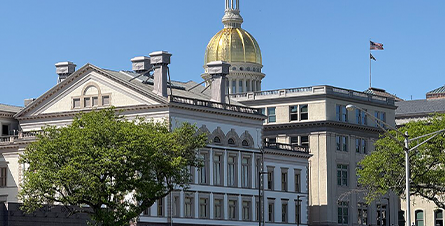The Cost of Treating PFAS: Alleviating the Taxpayer Burden
10.9.23
Per- and polyfluoroalkyl substances, or PFAS, are found in nearly half of the tap water in the U.S., according to a recent study from the U.S. Geological Survey. Named “forever chemicals” because of their strong chemical bond, PFAS remain in the environment, in humans and wildlife for a very long time.
These man-made chemicals have been used in industry and consumer products for decades and can be found in drinking water, air and food supply, affecting communities and posing a serious threat across rural, suburban, and urban areas.
What are the risks?
PFAS have been shown to have serious adverse effects on people’s health, including an increased risk of cancer, thyroid disorders, ulcerative colitis, an increase in liver enzymes, infertility, and pregnancy induced hypertension and preeclampsia.
Due to their widespread production and use, as well as their ability to remain in the environment, the Centers for Disease Control and Prevention (CDC) has found that most people in the U.S. have been exposed to some levels of PFAS. In fact, a study suggests that PFAS chemicals could be found in 98% of the U.S. population.
As a result of these risks, the U.S. Environmental Protection Agency (EPA) recently took a significant step to protect public health by proposing to establish legally enforceable levels for six PFAS compounds known to occur in drinking water, which would introduce the first-ever national standard to address PFAS in drinking water. If finalized, the standard would regulate PFOA and PFOS as individual contaminants, and will regulate four other PFAS — PFNA, PFHxS, PFBS, and GenX Chemicals — as a mixture. This will require public water systems to monitor for these chemicals. It will also require systems to notify the public and reduce PFAS contamination if levels exceed the proposed regulatory standards.
The Cleanup Costs of PFAS
At the state level, many agencies are taking steps to address PFAS contamination by identifying and disclosing where PFAS are manufactured, where releases to the environment are occurring, and their use in food packaging and other consumer items. However, further actions are needed to ensure environmental protection and public safety, including increased investment in developing laboratory methods to test for PFAS in drinking water, wastewater, and at contaminated sites, increased investment in research for treatment to remove PFAS in drinking water and at contaminated sites, as well as further research into associated human health risks.
Early estimates of the cost of removing PFAS from drinking water nationwide are about $400 billion. These cleanup costs are only expected to rise as the hazards of PFAS become clearer and more regulators set removal requirements.
Unfortunately, the burden to cover the costs of PFAS cleanup, to meet accelerating federal drinking water regulations, and provide healthcare for impacted individuals falls on state and local governments instead of the manufacturers responsible for PFAS production. For example, the American Water Works Association (AWWA) estimates that it could cost between $3.2-$5.7 billion annually to implement technologies to address EPA’s standard for PFAS in water.
For states that have already set drinking water limits for PFAS, such as New Jersey, Massachusetts, Michigan, and New York, compliance costs are quickly creeping up and starting to affect drinking water rates. Many communities around the country impacted by PFAS are facing billions of dollars for new water treatment technology. According to recent reports, for example, PFAS cleanup has contributed to increasing water utility rates for residents in Westford, Massachusetts (by 22%), and it is anticipated to raise water rates in Wausau, Wisconsin, where water bills could increase by almost $40 dollars a month, Hawthorne, New Jersey, by 13% in 2023 and another 13% in 2024.
Unless the manufacturers responsible for PFAS pollution are held accountable, taxpayers are likely to be the ones to bear the burden of the billions of dollars needed to treat PFAS-contaminated water.
Holding Polluters Accountable
To shield water customers and taxpayers from the massive cost of PFAS cleanup, state and local governments across the country are taking legal actions against manufacturers of toxic chemicals that are contaminating much of the nation’s drinking water. More than a dozen states, including Michigan, Alaska, Pennsylvania, North Carolina, New York and Colorado, and hundreds of municipalities and water systems have already filed lawsuits against PFAS manufacturers for contamination of drinking water or natural resources, such as lakes and groundwater.
After the EPA MCL takes effect, communities with drinking water that will exceed the regulatory limits will either need to take the contaminated sources out of service and get water from elsewhere or implement treatment solutions, both of which usually come at a great expense. Thus, it is anticipated that more entities will continue to pursue litigation against the responsible manufacturers in an attempt to recover these response costs.
Litigation Options: What is an MDL?
As municipalities and water utilities across the U.S. filed lawsuits claiming that their water supplies have been contaminated with PFAS from aqueous film-forming foam (AFFF), either alone or in combination with other PFAS-containing products, they have had their cases grouped together before the same court in a multidistrict litigation (MDL).
An MDL is a consolidation of many lawsuits from around the country involving similar claims by different plaintiffs against the same defendants. The purpose of the MDL is to consolidate the beginning stages of litigation while reserving each plaintiff’s right to take their own case to trial, with lawyers of their own choosing. Although MDLs can result in what are called “global settlements” of the claims brought by most or all the plaintiffs, it’s always up to each individual plaintiff whether to enter into a settlement. If the plaintiff is not happy with what’s being offered, it will have the chance to take its case out of the MDL, to federal court in its home state, and bring the case to trial there.
The AFFF MDL was formed in December 2018 and is being heard in the U.S. District Court for the District of South Carolina. There are four categories of plaintiffs: water providers, property owners, personal injury plaintiffs, and the sovereigns (states, territories, and tribes).
What are the Benefits of an MDL for PFAS?
If early cases in the MDL are resolved in favor of the plaintiffs, it often results in a domino effect of settlements for the remaining cases, which can be resolved without requiring lengthy discovery and pretrial litigation processes.
While the costs for cleaning up PFAS can be high, taking legal action doesn’t have to cost money up front. Some law firms, including SL Environmental Law Group, work on a contingency basis — meaning that the firms advance the costs of litigation and are paid only if there is a successful outcome.
Proceedings in the MDL over PFAS have been underway for water providers for three years. Additional plaintiffs can still join the MDL, which is likely one of the faster routes to try to obtain compensation your community has been impacted by PFAS.
PFAS Class Action Settlements
Recent developments in the ongoing MDL between PFAS manufacturers and water suppliers across the country that seek to hold polluters accountable for cleanup costs are settlements from 3M, agreeing to pay up to $12.5 billion, and DuPont and its related companies for $1.1859 billion — an important step forward for communities impacted by PFAS. All public water systems that are required to test under UCMR5 or have detected PFAS in at least one of their supply sources will be eligible to receive funds. Because the proposed agreements are structured as class action settlements, all eligible water systems will be included unless they opt out, regardless of whether they have filed lawsuits against the companies.
The PFAS class action settlements may help eligible systems recover clean-up funds, but the process of submitting claims is likely to be complex and depend on a variety of data about each contaminated source. Water systems will only have a short, 90-day timeframe to decide if they should opt-out from the settlement, which is set for December 4th for the DuPont settlement and December 11th for the 3M settlement. It is important to note, however, that communities will not know how much they’re eligible to receive until after the opt-out period has concluded. This is why, eligible municipalities and water systems will benefit from retaining legal counsel whether they plan to participate in the class action settlements or choose to opt-out and pursue litigation against 3M and/or DuPont instead, so they can receive assistance and guidance throughout the process.
SL Environmental Law Group has over 20 years of experience helping municipalities, water systems, and states hold polluters accountable and is currently focused on helping public entities recover the costs of PFAS contamination. SL already represents more than 100 water providers in the current AFFF MDL and over the past decades has helped over 150 clients, resulting in over $1.2 billion recovered in settlements and trials, to pay for the cost of contamination clean-up.
Recently, we created a playbook that walks through the strategies other systems have found successful when dealing with PFAS contamination. This playbook is free to access, feel free to gain additional insight by clicking here.



